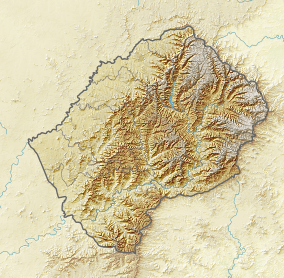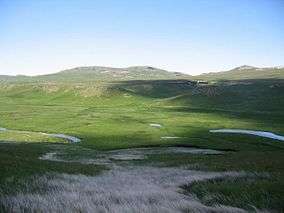Sehlabathebe National Park
| Sehlabathebe National Park | |
|---|---|
|
IUCN category II (national park) | |
|
Grasslands of Sehlabathebe National Park. December 2008. | |
 Map of Lesotho | |
| Location | Qacha's Nek District, Lesotho |
| Nearest city | Sehlabathebe |
| Coordinates | 29°53′56″S 29°07′16″E / 29.899°S 29.121°ECoordinates: 29°53′56″S 29°07′16″E / 29.899°S 29.121°E[1] |
| Area | 69.5 km2 (26.8 sq mi) |
| Established | 1969 |
The Sehlabathebe National Park is located in the Maloti Mountains in Qacha's Nek District, Lesotho, and is part of the larger Maloti-Drakensberg World Heritage Site. Home to both striking biological diversity as well as important cultural heritage, the park was first established on May 8, 1969.[2] The landscape is dominated by grassland of various types. The larger ecosystem as a whole performs invaluable functions including providing freshwater to Lesotho, South Africa and Namibia.[3]
History
The Park, Lesotho’s first national park, and second largest, is remote, rugged and beautiful, and getting there is always a worthwhile adventure, especially if you’re into wilderness, seclusion and fishing. Sehlabathebe means the “Shield of the Plateau”, mirroring the rolling grasslands, wild flowers and silence provide a sense of complete isolation.
Location
Situated in the south-east corner of Lesotho, at an average elevation of some 2,400 metres above sea level access could be challenging as it is rather remote.
Access
By horseback or on foot
This is the way locals do. Access from the Bushman's Nek pass, near Underberg KwaZulu-Natal. Khotso Horse Trails are currently the only tour operator providing this service on horseback, though the pass is accessible to all on foot.
By vehicle
A road accessible with 4X4 vehicles lead to the park from the town Thaba-Tseka 122 km to the north passing the Matabeng mountain pass. The approximate travel time is 12 hours. Another road accessible with 4X4 vehicles lead to the park from the west and passes the Ramatselitso border crossing (36 km / 4 hours) with South Africa as well as the Qachas Nek border crossing (106 km / 12 hours).[4]
Accommodation
The only current available accommodation in the park is camping nearby the old Jonathan Lodge. Jonathan Lodge has been closed down during 2013. A new 72-bed lodge has been build but is not operational as yet.[5] Accommodation is available near the park at a number of locations in the nearby settlements of Sehlabathebe, and Mavuka.
Attractions
The park provides the best secluded environment nature could offer with soaring mountain vistas, secluded rock pools, waterfalls, rock dwellings, massive overhangs, rock art, rock arches and a beautiful and unique ecosystem of plants, birds and animals.[6] It offers a significant habitat to a range of unique Afro-Alpine and Sub-Alpine plants, mammals, avifauna, reptiles, amphibians and fish. It has spectacular scenery with unique rock formations. Most of the Park is taken up by a designated wilderness area and although small by international standards, it retains its natural character and is uninhabited. The Park is home to various outstanding biodiversity species, some of which are endemic and endangered. There are three endangered species, the Maloti Minnow (Maluti redfin, Pseudobarbus quathlambae), a critically endangered species of fish found only in the Park, and the Cape Vulture (Gyps coprotheres) and Bearded Vultures (Gypaetus barbatus).[7] The Tsoelikanyane waterfall is the biggest waterfall in the park.[8] This site hosts 23 percent of the plant species in the whole of Maluti Drakensberg area. Apart from the unique floral presence in the park, there is a record number of 65 rock art sites which have been identified in the Park, and other forms of previous habitation of the site.
World Heritage status
This site was added to the UNESCO World Heritage Tentative List on October 8, 2008 in the Mixed (Cultural + Natural) category.[3] This park will be included into the Maloti-Drakensberg Transfrontier Conservation Area, Peace Park. Sehlabathebe is currently run under the jurisdiction of the Ministry of Tourism, Environment and Culture.
Notes
- ↑ "Sehlabathebe National Park". protectedplanet.net.
- ↑ Ramutsindela, M. (2007) p 68
- 1 2 UNESCO World Heritage Centre. "Sehlabathebe National Park - UNESCO World Heritage Centre". unesco.org. Retrieved 19 March 2015.
- ↑ "Welcome to Tracks4Africa". tracks4africa.co.za. Retrieved 19 March 2015.
- ↑ "Sehlabathebe Accommodation - 4x4 Community Forum". 4x4community.co.za. Retrieved 19 March 2015.
- ↑ "Drakensberg Adventures Sehlabathebe Tour". sanilodge.co.za. Retrieved 19 March 2015.
- ↑ UNESCO World Heritage Centre. "Maloti-Drakensberg Park". unesco.org. Retrieved 19 March 2015.
- ↑ stephen. "Malealea Tours in Lesotho - Sehlabathebe - Jonathan's Lodge". malealeatours.com. Retrieved 19 March 2015.
References
- Sehlabathebe National Park - UNESCO World Heritage Centre Retrieved 2009-03-02.
- Ramutsindela, M. (2007), Transfrontier Conservation in Africa: At the Confluence of Capital, Politics, and Nature, CABI. ISBN 1-84593-221-8
